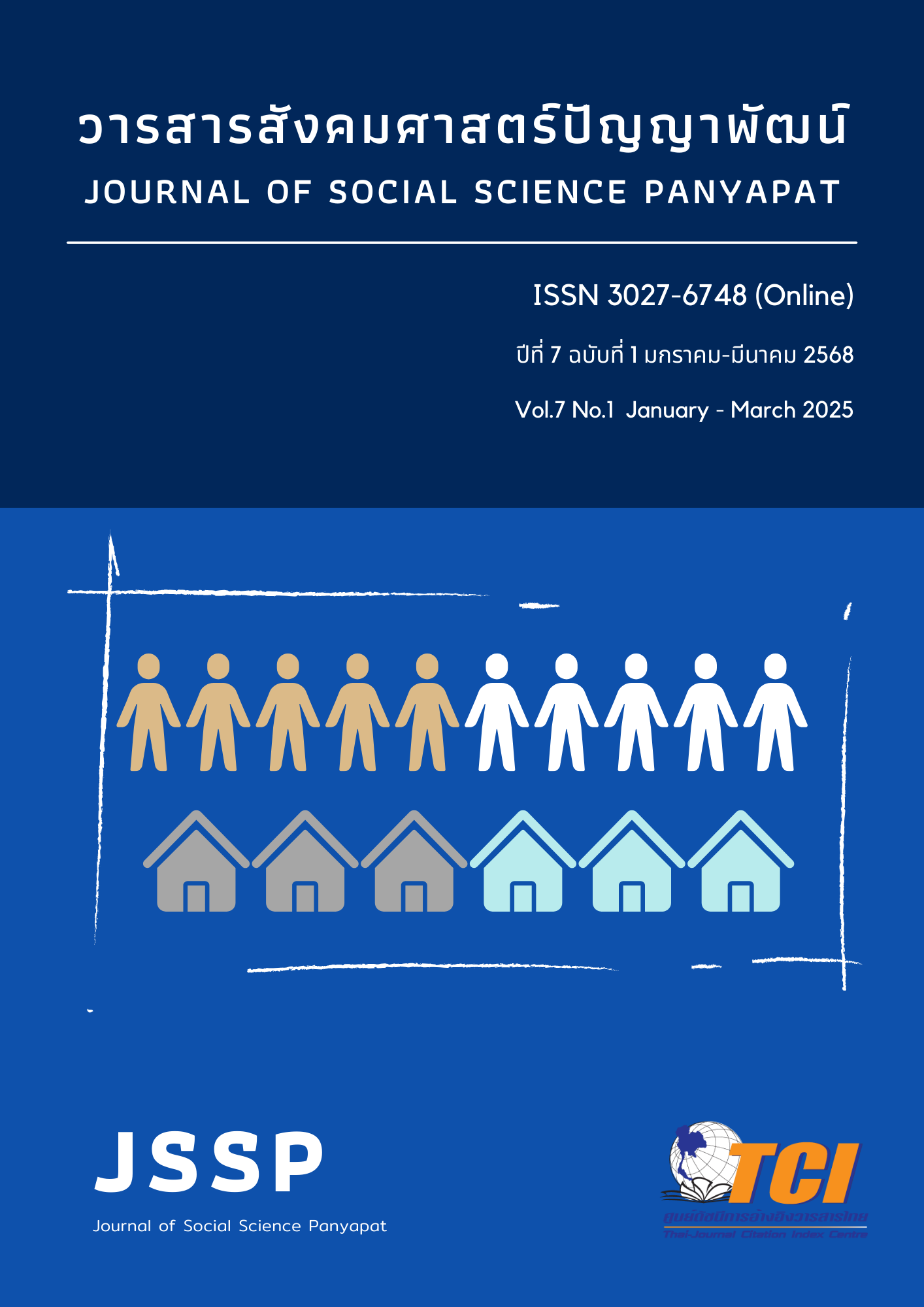Organizational Commitment of Civil Servants to the Department of Employment
Keywords:
Organizational Commitment, Civil Servants, The Department of EmploymentAbstract
The objectives of the research were (1) to study the levels of organizational climate and organizational commitment of the civil servants to the Department of Employment (DoE), (2) to compare the levels of organizational commitments of DoE civil servants based on personal factors, and (3) to conduct quantitative study about correlations between organizational climate and organizational commitment of DoE civil servants. The methods used were Questionnaire collecting data of 400 civil servants of DoE under the Ministry of Labour, Descriptive Statistics, T-Test, One-way ANOVA, and Pearson's Correlation Coefficient Analysis. The findings were 1) most DoE civil servants ranked overall high for the organizational climate and organizational commitment. Every individual aspect also ranked high. In terms of organizational climate, Organizational belonging, Continuance Commitment and Normative Commitment ranked the highest on average. 2) DoE civil servants with different ages, marital status, average monthly income and period of employment had different levels of organizational commitment, which has statistical significance at 0.05. While DoE civil servants with different genders and educational displayed similar levels of organizational commitment. 3) Organizational climate correlated to organizational commitment of the DoE civil servants at a moderate level in a positive direction (r=0.63), which has statistical significance at 0.05.
References
กมลวรรณ เทพจั้ง และ พงษ์ศักดิ์ เพ็ชรสถิตย์. (2564). บรรยากาศองค์การที่มีผลต่อแรงจูงใจใฝ่สัมฤทธิ์ในการปฏิบัติงานของเจ้าหน้าที่ราชทัณฑ์ ในเขตจังหวัดปทุมธานี. วารสารรัฐศาสตร์ มหาวิทยาลัยมหามกุฏราชวิทยาลัย, 1(6), 40-52.
กรมการจัดหางาน. (2567). จำนวนบุคลากร. สืบค้นจาก http://doe.go.th/prd/hrad/custom/param/site/138/cat/40/sub/0/pull/detail/view/detail/object_id/3114.
กรมการจัดหางาน. (2568). วิสัยทัศน์/พันธกิจ/และค่านิยม. สืบค้นจาก https://www.doe.go.th/prd/main/general/param/site/1/cat/27/sub/0/pull/singleview/view/detail/object_id/2.
ดนัย ผ่องแผ้ว, ศรายุทธ คชพงศ์, กุลชาติ บุญกลั่นสอน และ โชติ บดีรัฐ. (2564). ทุนมนุษย์: การจัดการทรัพยากรมนุษย์ในองค์การภาครัฐ. Journal of Modern Learning Development, 6(5), 298-302.
นิธิธรรม ศุนาลัย และ รวิภา ธรรมโชติ. (2566). สาเหตุและผลของความผูกพันต่อองค์การของข้าราชการตำรวจ สังกัดกองบัญชาการศึกษา สำนักงานตำรวจแห่งชาติ. วารสารสหวิทยาการสังคมศาสตร์และการสื่อสาร, 6(3), 67-80.
พัณนิดา เถายะบุตร. (2566). บรรยากาศองค์การที่ส่งผลต่อแรงจูงใจในการปฏิบัติงานของครูในโรงเรียน สังกัดสำนักงานเขตพื้นที่การศึกษาประถมศึกษาสกลนคร เขต 2. (ครุศาสตรมหาบัณฑิต, มหาวิทยาลัยราชภัฏสกลนคร).
พัทธดนย์ ดนยรักษ์ นนทกะตระกูล. (2566). คุณภาพชีวิตในการทำงาน ความสุขในการทำงาน และความผูกพัน ของข้าราชการกรมการจัดหางาน กระทรวงแรงงาน. (รัฐศาสตรมหาบัณฑิต, มหาวิทยาลัยธรรมศาสตร์).
พิตะวัน ละออศรี. (2567). ปัจจัยที่ส่งผลต่อความผูกพันในองค์การของพนักงาน Generation Y บริษัทเอกชน ในกรุงเทพมหานคร. (บริหารธุรกิจมหาบัณฑิต, มหาวิทยาลัยรามคำแหง).
พีระ แก้วสะอาด. (2564). อิทธิพลของบรรยากาศองค์การที่ส่งผลต่อความผูกพันต่อองค์การ ของพนักงาน บมจ.ธนาคารกรุงไทย สำนักงานใหญ่. (บริหารธุรกิจมหาบัณฑิต, มหาวิทยาลัยศรีนครินทรวิโรฒ).
ภัทราพร มูลสถาน และ ฐิติมา ไชยะกุล. (2566). ความสัมพันธ์ระหว่างการทำงานเป็นทีม การรับรู้การสนับสนุนจากองค์การ ความผูกพันต่อองค์การของพนักงาน และประสิทธิภาพการปฏิบัติงานของพนักงาน ระดับปฏิบัติการ บริษัทขนส่งและโลจิสติกส์ ในเขตท่าเทียบเรือแหลมฉบัง จังหวัดชลบุรี กรณีศึกษา บริษัท ABC จำกัด. วารสารสังคมศาสตร์ปัญญาพัฒน์, 5(3), 41-54
วราภรณ์ ศรีวงษ์ และ จุรีวัลย์ ภักดีวุฒิ. (2565). บรรยากาศองค์การที่ส่งผลต่อความผูกพันต่อองค์การของเจ้าหน้าที่สังกัดสำนักงานการปฏิรูปที่ดินเพื่อเกษตรกรรม (ส.ป.ก.) ในเขตภาคตะวันออกเฉียงเหนือตอนบน. วารสารมนุษยศาสตร์และสังคมศาสตร์ มหาวิทยาลัยมหาสารคาม, 41(6), 109-124.
สุธินี ฤกษ์ขำ. (2560). การพัฒนาทรัพยากรมนุษย์ : หลักการและการประยุกต์. (พิมพ์ครั้งที่ 2). กรุงเทพฯ: โรงพิมพ์แห่งจุฬาลงกรณ์มหาวิทยาลัย.
อารีรัตน์ เสสตะญาติ และ กฤษฎา มูฮัมหมัด. (2566). ปัจจัยที่มีผลต่อความผูกพันในองค์การของพนักงานบริษัทเอกชน กลุ่มเจน เนอเรชั่นซี ในเขตกรุงเทพมหานครและปริมณฑล. วารสารวไลยอลงกรณ์ปริทัศน์, 13(2), 161-176.
Cronbach, L. (1990). Essentials of psychological testing. (5th ed). New York: Harper & Row.
Likert, R. (1961). New patterns of management. New York: McGraw-Hill Book Company.
Meyer, J. P., & Allen, N. J. (1991). A three-component conceptualization of organizational commitment. Human resource management review, 1(1), 61-89.
Robert Stringer. (2002). Leadership and Organizational Climate: the cloud chamber effect. New Jersey: Pearson Education, Inc.
Downloads
Published
How to Cite
Issue
Section
License
Copyright (c) 2025 Journal of Social Science Panyapat

This work is licensed under a Creative Commons Attribution-NonCommercial-NoDerivatives 4.0 International License.


